#maschinenfabrik
Explore tagged Tumblr posts
Text
Die Maschinenfabrik R. Wolf Magdeburg-Buckau 1862 – 1912
Die Lebensgeschichte des Begründers und die Entwicklung der Werke von Conrad Matschoss • 📖 ISBN 978-3-7597-2237-9 • Erhältlich in allen guten Buchhandlungen oder direkt beim Verlag: https://www.bod.de/buchshop/die-maschinenfabrik-r-wolf-in-magdeburg-buckau-1862-1912-9783759722379 ℹ️ Die Geschichte der Firma R. Wolf steht beispielhaft für den Aufstieg der deutschen Maschinenindustrie in der zweiten Hälfte des 19. Jahrhunderts. Sie zeigt, wie bleibende Erfolge nur durch Güte der Arbeit, durch unermüdliches Streben, das Beste zu erreichen, erlangt werden können. Die Lebensgeschichte des Begründers lässt besonders deutlich erkennen, wie technisches Können, vereint mit kaufmännischer und organisatorischer Begabung, und getragen von hingebender Liebe zum selbsterwählten Beruf, für die Verhältnisse des wirklichen Lebens letzten Endes die Triebkräfte sind, die alle Schwierigkeiten überwinden. Der Technikhistoriker Conrad Matschoss (1871 – 1942) verfasste diese Denkschrift aus Anlass des fünfzigjährigen Bestehens der Maschinenfabrik R. Wolf in Magdeburg-Buckau und schuf damit ein ausführliches und mit über 150 Fotos und Zeichnungen reichhaltig illustriertes Zeitdokument der Industriegeschichte.
#editionepilogde#buch#bücher#rwolf#wolfmagdeburg#maschinenfabrik#maschinenbau#fabrikation#magdeburg#buckau#magdeburgbuckau#magdeburgsalbke#zeitreisen
0 notes
Text
Dampfzug mit Lokomotive Bonne - Video 1080p 60fps (inkl.-Audio)
Lokomotive 57 S/N: 4478 (1943) van Hoogovens Stoom IJmuiden (HSIJ) hier bei Eys-Wittem auf der Strecke der Zuid-Limburgse Stoomtrein Maatschappij (ZLSM) (NL)
Steam train with locomotive Bonne - Video 1080p 60fps (incl. audio)
Locomotive 57 S/N: 4478 (1943) van Hoogovens Stoom IJmuiden (HSIJ) here near Eys-Wittem on the line of the Zuid-Limburgse Stoomtrein Maatschappij (ZLSM) (NL)
Train à vapeur avec locomotive Bonne - Video 1080p 60fps (incl.-audio)
Locomotive 57 S/N : 4478 (1943) van Hoogovens Stoom IJmuiden (HSIJ) ici près de Eys-Wittem sur la ligne de la Zuid-Limburgse Stoomtrein Maatschappij (ZLSM) (NL)
Stoomtrein met locomotief Bonne - Video 1080p 60fps (incl. audio)
Loc 57 S/N: 4478 (1943) van Hoogovens Stoom IJmuiden (HSIJ) hier bij Eys-Wittem op de lijn van de Zuid-Limburgse Stoomtrein Maatschappij (ZLSM) (NL)
Video 1080p 60fps (incl-Audio)
#dampflokblog.de#Bonne#ZLSM#steam train#railway#dampflok#eisenbahn#stoom locomotief#steam locomotive#локомотив#lokomotywa#locomotive à vapeur#鉄道#Eys-Wittem#Maschinenfabrik Esslingen#video#BR81#BR 81
45 notes
·
View notes
Text

1 note
·
View note
Text










schloß philippsruhe, museum hanau: industriedenkmäler hanau, photographien von reinhard franz und jochen stenger, ausstellungskatalog 1987 exzerpt, pdf
#industriedenkmäler hanau#photographs#hanau#reinhard franz#jochen stenger#exhibition#schloß philippsruhe#museum hanau#seewald#ladenbau#maschinenfabrik weinig#platinschmelze#w.c. heraeus#reichling & eberhard#schlachthaus#mainhafen#freigerichtstraße#about photography#stadtbibliothek leipzig#kinski geisel#books#research#boring postcards 2#bauhaus schleef wittenau
1 note
·
View note
Text

Jakob Tuggener. Control clocks, Maschinenfabrik Oerlikon, 1930s.
37 notes
·
View notes
Text
The Lauffen-Frankfurt Experiment of 1891: A Landmark in Electrical Engineering

In 1891, an experiment in Germany transformed the future of electricity. The Lauffen-Frankfurt experiment marked the world's first successful long-distance transmission of three-phase electric power. Stretching approximately 175 kilometers (or 109 miles) from Lauffen am Neckar to Frankfurt am Main, it was a highlight of the International Electrotechnical Exhibition. Key figures included Oskar von Miller, the exhibition's chief organizer; Mikhail Dolivo-Dobrovolsky, who designed the three-phase generators; and Charles Eugene Lancelot Brown, an engineer from Switzerland's Maschinenfabrik Oerlikon, which supplied much of the equipment.

So, what made this experiment groundbreaking? They set up a three-phase AC system powered by a robust 300-horsepower generator, stepping up the voltage from 55 volts to an impressive 8,500 volts for efficient long-distance transmission. This setup, featuring three copper wires, successfully delivered enough power to run a 100-horsepower motor and illuminate 1,000 incandescent lamps at the exhibition.
What is three-phase? Think of it like a three-lane highway. With just one lane (single-phase), you can only have one car (or current) at a time, which leads to traffic jams. But with three lanes, multiple cars can move smoothly side by side, ensuring a steady flow. This means electricity can be delivered more efficiently and with less flicker, making it ideal for powering everything from lights to heavy machinery. While it might seem logical to add more phases for even better efficiency, three-phase systems are often the sweet spot. They provide balanced and constant power delivery, making them highly efficient for most applications. Adding more phases increases complexity without significant efficiency gains—like a six-phase system that might reduce ripple but complicates design, equipment, and maintenance.
The significance? This experiment demonstrated that electrical power could be transmitted over long distances with much less energy loss than DC systems. It achieved an impressive 75% efficiency, showcased the advantages of a three-phase system—like smoother power delivery—and highlighted the importance of voltage transformations for effective transmission. Essentially, they figured out how to make electricity travel like a well-coordinated relay race, where each runner (or phase) keeps the momentum going.

After the experiment, discussions arose about who truly invented the three-phase system. Charles Brown, a key figure in the German experiment, stepped up to give credit where it was due. In a letter published in The Electrical Review on February 12, 1892, he acknowledged the significance of the three-phase system while emphasizing that the main goal was to prove the feasibility of safely transmitting high-tension currents over long distances. He noted that although the three-phase current added complexity, its benefits for powering multiple motors simultaneously were worthwhile. Most importantly, he stated, “The three-phase current as applied at Frankfurt was due to the labors of Mr. Tesla and will be found clearly specified in his patents.��
Brown specifically referenced Tesla's patents filed on October 12, 1887: Patent No. 381,968 for an "Electromagnetic Motor" and Patent No. 382,280 for "Electrical Transmission of Power," which detailed a three-phase power system. These patents were foundational to the technology used in the Lauffen-Frankfurt experiment.
Brown’s acknowledgment highlights Tesla’s innovative spirit, which transcended borders and spurred advancements in Europe. His patents laid the groundwork for the three-phase current used in this experiment.
Tesla's patents weren’t mere formalities; they were foundational blueprints for modern electrical systems, including designs for polyphase AC systems that predated the Lauffen-Frankfurt experiment by several years. Brown's emphasis on the significance of Tesla's patents for the three-phase current demonstrated that many who discredit Tesla, even in today's debates, overlook their importance. This highlights Tesla's crucial role in developing the technology that both the German experiment and today’s innovations depend on.
In short, the Lauffen-Frankfurt experiment marked a pivotal moment in electrical engineering, proving the viability of long-distance AC power transmission and laying the foundation for today’s electrical grid. While it showcased German ingenuity, it also highlighted the collaborative nature of scientific progress, with Tesla's earlier contributions illuminating the path forward. The interplay between his theoretical innovations and the practical applications of this experiment illustrates how technological progress often builds on the brilliant ideas of others.
38 notes
·
View notes
Text
An introduction to VR passenger carriages, part 1: the blue carriages
In our next series of introducing our rolling stock, we will be looking at passenger carriages. I was actually thinking of doing multiple units next, but @hapotonradio requested I do the blue carriages and a lot of people seemed to like the idea so here we go.
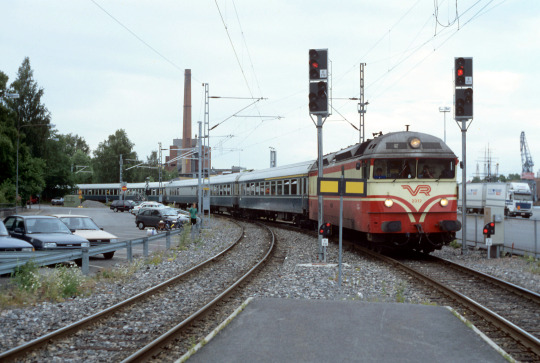
A Dr13-hauled train consisting of blue carriages arriving in Turku Harbour, 1995. Falk1, Wikimedia Commons
I can already hear foreigners (and non-rail enthusiast Finns too) going "what the hell are the blue carriages?" Well, the blue carriages were/are the first Finnish steel-bodied passenger carriages, with over 600 units (depending a bit on what you count as being actual blue carriages) of different types built between 1961 and 1986. Today, almost all of them have been retired. Which is a shame, because they were sexy.
The first 15 blue carriages were built by the West German Maschinenfabrik Esslingen, who also designed them, in 1961. This original batch were equipped with different types of boggies, from which the Minden-Deutz boggie was chosen for the eventual mass-produced series built in-house by the VR Pasila workshop starting from 1964 (Valmet also built a small number of carriages).
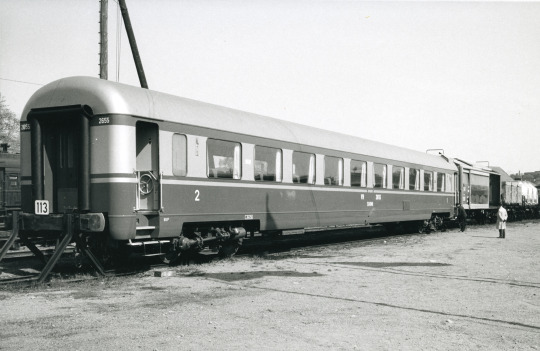
A combined 1st and 2nd class carriage as built, 1964. At this point they still had steel covering the underbody from the sides. These hems were later removed to better display the arousing technical bits. Olavi Karasjoki, Suomen rautatiemuseo.

President Kekkonen (the bald dude) visiting the above carriage. Olavi Karasjoki, Suomen rautatiemuseo.
The initial batch consisted of ten 2. class carriages (littera Eit), four combined 1. and 2. class coaches (lit. CEit) and one 1. class coach (lit. Cit). As you can maybe figure out, the -t at the end stood for teräs, steel, to distinguish from the old wood-bodied coaches. In addition to the regular first- and second-class coaches, the blue carriages' base design was adopted for restaurant cars (litteras Rbkt, Rt, Rkt and Rk), combined condutor's and luggage cars (lits. Fot, Efit and Efiti), sleepers (CEmt), aggregate cars to use on non-electrified tracks (Eifet), carriages with children's playrooms (ELht), postal carriages (Pot), military transport (Ems), prisoner transport (Nom), special carriages for the president and cabinet (A), and even a one-off disco carriage. The latter in particular fucked severely. All those sweaty bodies having it on inside a train...
Some sources also list the Eil-class local traffic coaches as blue carriages, but since they had some structural differences and were originally painted red rather than blue, I'm going to cover them in a separate entry.
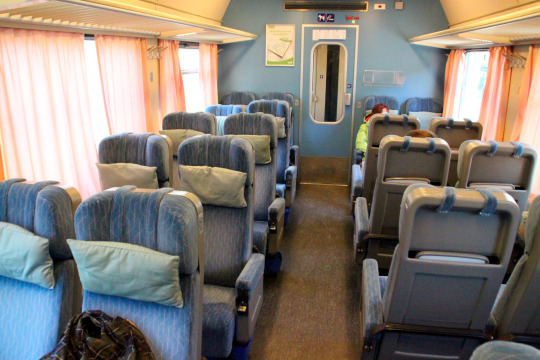
Interior of a 2nd class carriage. My photo
Over the quarter of a century the blue carriages were in production, numerous improvements were made to the original design; most notably, the original top service speed of 120 km/h was increased first to 140 km/h and then to 160 km/h in some units.
By the time the last blue carriages were delivered in 1986, their star was already waning. In 1988, the first new Intercity carriages (in a white and red IC delivery) were delivered, and Intercity trains replaced the blue-carriaged special express (erikoispikajuna) trains as the flagship product. With the arrival of the Intercity carriages, and the double-decker carriages from 1998 onwards, the blue carriages were phased out.
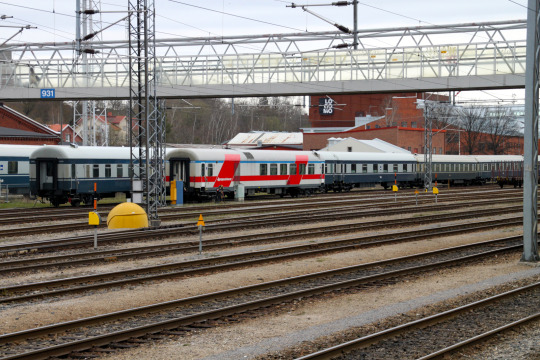
Blue carriages at the Turku depot, an Eifet aggregate car repainted in the Intercity livery in the 1990s and CEmt sleepers (both carriages visible behind the Eifet; the sleepers have asymmetric window arrangements). My photo
Today, the only blue carriages still in use in the iconic original livery as sleepers in night trains to Lapland, and prison transport carriages. Some restaurant cars, aggregate cars and conductor's carriages still exist, but they have been repainted in the newer liveries. Several blue carriages have also been preserved by different instances and they're relatively commonly seen in heritage/museum trains these days.
57 notes
·
View notes
Video
Dampflok 99 731, Bj. 1928 durch Sächsische Maschinenfabrik por Thorsten Mothes Por Flickr: Ausfahrt aus dem Bahnhof Bertsdorf
10 notes
·
View notes
Text





BERLIN-LUBECKER MASCHINENFABRIK G43
8X57 MM; 22'' barrel, NUMBERS MATCHING ON THIS 1944 G43
9 notes
·
View notes
Photo



SIR GAYLORD THE FIFTH JUST GOT A DESIGN UPDATE BABY
JUDEA
Pronouns: He/They Engine basis: C12, Saechsische Maschinenfabrik production Built year: 1893 Wheel configuration: 2-6-0T Fuel type: Wood Height (engine): 2,52 m
Age (Casa Tidmouth): mid 30s (as per 1999) Height (Casa Tidmouth): 162 cm
Judea is a confident and laid back goods train that doesn’t like overthinking big problems. He always believes that there’s always a solution to every issue, mainly due to his down-to-earth nature instead of blind optimism. They love to get along and form amicable relationships with various engines regardless of where their morality stood. Judea doesn’t like overly whiny folks, though. He also loves terrorizing big, proud engines, mainly Gordon (something about him just intrigues Judea), James (coleslaw vs potato salad), and Duck (he’s fun to provoke).
Judea has a health condition that makes him randomly stop on his tracks and “fall asleep”, something akin to narcolepsy in humans. They don’t really mind it much or take to heart other’s comments of his disability, but he does get irritated whenever people assume things that he couldn’t do because of it. His pride is quite easy to wound, and his perception of others can quickly change whenever something they say hits the sore spot. He does feel bad about this because he doesn’t like thinking badly about others. In addition, even though Judea is able to understand the things others go through, he finds it hard to emphatize with others.
About his years being forced to work for the Dutch colonizers? He didn’t really enjoy it.
Trivia:
He was saved from being scrapped after being bought by the Sir Topham Hatt at the time. Judea had always interpreted this as him taking pity on them, which made them feel a bit uncomfortable towards the controller.
Besides English, they can also speak Indonesian, a bit of German, and a bit of Dutch. He’s got a bit of Indonesian accent when he talks, too.
There was once an instance where Judea saw Gordon arrive at Knapford Station and (with a smirk) they immediately went “Well, well, well. If it isn’t Homotron 6000,”
Despite witnessing a lot of things during the Dutch colonization years, Judea remained relatively… unbothered. In fact, they don’t mind joking about the more macabre sides of the war.
Favorite quotes including: “Skill issue”, “Ah ah ah I know you’re mad 😂”, “Goodnight girl. I see you tomorrow”, “Achtung, baby!”, and “You know, back in Dutch East Indies they had an open casket funeral for one of the Dutch officers. Like, super awkward.”
The scar below his lip is due to an accident at the sea. Judea doesn’t like talking about it not because it mentally hurts, but because it’s so embarassing and he loves his pride more than anything..
The scar on his right eyebrow was when a bunch of crates fell on him and one of the crate’s corners hit his face. (“My dermatologist will hear about this!!!”)
(Casa Tidmouth) The scars on his left hand is from accidentally grazing it against a door lock strike plate.
Judea have had their fair share of rumors (and occasionally, insensitive comments) coming from the big engines when he first arrived on Sodor, mainly jabs at his fuel type and health condition.
He’s in the Aro/Ace spectrum. However, they do enjoy messing around with others and teasing them, mainly a certain, easily flustered, big blue engine…
Likes: Sunday School songs, the instant noodle Indomie, terrorizing big, haughty, mean engines
Dislikes: the Dutch. Not entirely because of what they did to his countrymen, though. He just thinks Europeans are kind of funny in an embarrassing way
#thomas the tank engine#thomas and friends#ttte judea#trainsona#tte oc#senjart#casa tidmouth#LIVERY UPDATE AFTER YEARS YEEHAW
121 notes
·
View notes
Text
Gustav's beginnings!
Hello everyone! First of all, thank you for following this blog! There is so much to write about that I don’t even know know where to start, so I guess we will be starting from the beginning :-)))
We all know that Gustav Friedrich Fröhlich was born in Hanover on March 21, 1902 - but did you know that he was an illegitimate child and did not grow up with his birth parents?
Back in those days, things were very hard for children born out of wedlock. There was practically no way for them to grow up with their biological parents: for the mother, this would result in a terrible scandal and a perpetual staining of her social standing and reputation, and that is why most women chose to travel to some other place and give birth to their children in secret before going back home and acting as if nothing had happened - so that nobody would know that they had had a child.
In Gustav’s case, his father would later become a pretty important person, a local engineer who would also be director and technical manager of a factory (the Halleschen Maschinenfabrik): his name was Karl-Friedrich König (1876-1952), though some online sources state his first name as being Gustav instead, which is of course interesting.
Not much is known about Gustav‘s mother outside of the information Gustav himself provided in his autobiography ‘Waren das Zeiten’, published in the 1980s, but she seems to have been the daughter of a local worker, who was actually having Gustav’s father (who was a student by then) as a lodger at his house when the two fell in love. Her name was Hedwig Therese Sophie René Fröhlich, and of course Gustav inherited her surname.
In any case, when Gustav was born in such a scandalous way, his father didn’t want to take any responsibility, and his mother, feeling rejected and outcast, had a sort of breakdown, which led her to give up the child on the spot and to only come back for him years later. In the meanwhile Gustav spent all his formative years with his grandparents and foster parents, who were extremely fond of music and helped him develop an appreciation for it. And he left home very early to start a career as a journalist- his first professional venture before setting his heart on acting.
One interesting detail: Gustav knew who his biological parents were, and spent quite a bit of time with his mother during his younger years - as an adult and famous actor, he even developed a close friendship with one of his half-brothers (more about this in the future!). For Karl-Friedrich König would have other children just a few years after Gustav’s birth, among whom renowned philosopher and sociologist René König (1906-1992).
Here is the cover of Gustav’s own book (for both the hardcover and the paperback editions), where he tells his life story - highly recommended if you can read German!

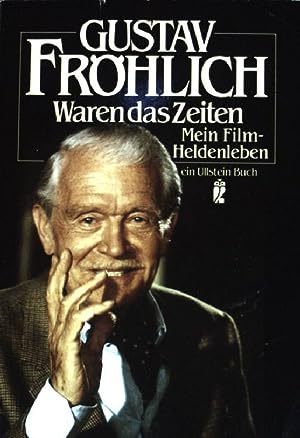
#gustav frohlich#silent cinema#german cinema#weimar#freder fredersen#metropolis#metropolis 1927#fritz lang#german expressionism
7 notes
·
View notes
Text
Lokomotive Bonne Tender voraus auf dem Weg nach Eys-Wittem (NL) - Video 1080p 60fps (inkl. Audio)
Locomotive Bonne Tender ahead on the way to Eys-Wittem (NL) - Video 1080p 60fps (incl. Audio)
Locomotive Bonne Tender en tête sur la route d'Eys-Wittem (NL) - vidéo 1080p 60fps (audio inclus)
Locomotief Bonne Tender voor op weg naar Eys-Wittem (NL) - Video 1080p 60fps (incl. audio)
#dampflokblog.de#Bonne#ZLSM#steam train#railway#dampflok#eisenbahn#stoom locomotief#steam locomotive#локомотив#lokomotywa#locomotive à vapeur#鉄道#video#locomotive#lokomotive#Maschinenfabrik Esslingen#BR81#BR 81
17 notes
·
View notes
Text

Antriebsrad von der Gotthardlokomotive Ce 6/8 II 14270 mit dem Übernamen Krokodil, gebaut 1921 von der Maschinenfabrik Oerlikon, in Betrieb bis 1969. Die Höchstgeschwindigkeit war 65 Km/h, Dauerleistung 1340 Ps bei 40 Km/h, Triebraddurchmesser 1350mm. Die Lokomotive steht nun wieder in Zuerich Oerlikon zur Besichtigung.
2 notes
·
View notes
Text
Automotive Crankshaft Market To Witness the Highest Growth Globally in Coming Years

The report begins with an overview of the Automotive Crankshaft Market 2025 Size and presents throughout its development. It provides a comprehensive analysis of all regional and key player segments providing closer insights into current market conditions and future market opportunities, along with drivers, trend segments, consumer behavior, price factors, and market performance and estimates. Forecast market information, SWOT analysis, Automotive Crankshaft Market scenario, and feasibility study are the important aspects analyzed in this report.
The Automotive Crankshaft Market is experiencing robust growth driven by the expanding globally. The Automotive Crankshaft Market is poised for substantial growth as manufacturers across various industries embrace automation to enhance productivity, quality, and agility in their production processes. Automotive Crankshaft Market leverage robotics, machine vision, and advanced control technologies to streamline assembly tasks, reduce labor costs, and minimize errors. With increasing demand for customized products, shorter product lifecycles, and labor shortages, there is a growing need for flexible and scalable automation solutions. As technology advances and automation becomes more accessible, the adoption of automated assembly systems is expected to accelerate, driving market growth and innovation in manufacturing. Automotive Crankshaft Market Size, Share & Industry Analysis, By Type (Flat Plane, Cross Plane), By Material (Cast Steel, Forged Iron/steel), By Vehicle type (Passenger Cars, Commercial Vehicles) Others and Regional Forecast, 2021-2028
Get Sample PDF Report: https://www.fortunebusinessinsights.com/enquiry/request-sample-pdf/102231
Key Strategies
Key strategies in the Automotive Crankshaft Market revolve around optimizing production efficiency, quality, and flexibility. Integration of advanced robotics and machine vision technologies streamlines assembly processes, reducing cycle times and error rates. Customization options cater to diverse product requirements and manufacturing environments, ensuring solution scalability and adaptability. Collaboration with industry partners and automation experts fosters innovation and addresses evolving customer needs and market trends. Moreover, investment in employee training and skill development facilitates seamless integration and operation of Automotive Crankshaft Market. By prioritizing these strategies, manufacturers can enhance competitiveness, accelerate time-to-market, and drive sustainable growth in the Automotive Crankshaft Market.
Major Automotive Crankshaft Market Manufacturers covered in the market report include:
Some of the major companies that are present in the automotive crankshaft market include Thyssenkrupp AG, Nippon Steel Integrated Crankshaft LLC, Braynt Racing Inc., Arrow Precision Ltd., Maschinenfabrik Alfing Kessler GmbH, Mahindra CIE, Tianrun Crankshaft Co., Ltd., among others.
The crankshaft in the diesel engine has to serve higher strength and vibrations. Owing to this, many crankshaft manufacturers are developing advanced crankshaft with improved fatigue strength, reliability, and quality. Also, the crankshafts are manufactured with the latest trend of steelmaking processes by materials with high strength, and this factor is also expected to drive the automotive crankshaft market.
Trends Analysis
The Automotive Crankshaft Market is experiencing rapid expansion fueled by the manufacturing industry's pursuit of efficiency and productivity gains. Key trends include the adoption of collaborative robotics and advanced automation technologies to streamline assembly processes and reduce labor costs. With the rise of Industry 4.0 initiatives, manufacturers are investing in flexible and scalable Automotive Crankshaft Market capable of handling diverse product portfolios. Moreover, advancements in machine vision and AI-driven quality control are enhancing production throughput and ensuring product consistency. The emphasis on sustainability and lean manufacturing principles is driving innovation in energy-efficient and eco-friendly Automotive Crankshaft Market Solutions.
Regions Included in this Automotive Crankshaft Market Report are as follows:
North America [U.S., Canada, Mexico]
Europe [Germany, UK, France, Italy, Rest of Europe]
Asia-Pacific [China, India, Japan, South Korea, Southeast Asia, Australia, Rest of Asia Pacific]
South America [Brazil, Argentina, Rest of Latin America]
Middle East & Africa [GCC, North Africa, South Africa, Rest of the Middle East and Africa]
Significant Features that are under offering and key highlights of the reports:
- Detailed overview of the Automotive Crankshaft Market.
- Changing the Automotive Crankshaft Market dynamics of the industry.
- In-depth market segmentation by Type, Application, etc.
- Historical, current, and projected Automotive Crankshaft Market size in terms of volume and value.
- Recent industry trends and developments.
- Competitive landscape of the Automotive Crankshaft Market.
- Strategies of key players and product offerings.
- Potential and niche segments/regions exhibiting promising growth.
Frequently Asked Questions (FAQs):
► What is the current market scenario?
► What was the historical demand scenario, and forecast outlook from 2025 to 2032?
► What are the key market dynamics influencing growth in the Global Automotive Crankshaft Market?
► Who are the prominent players in the Global Automotive Crankshaft Market?
► What is the consumer perspective in the Global Automotive Crankshaft Market?
► What are the key demand-side and supply-side trends in the Global Automotive Crankshaft Market?
► What are the largest and the fastest-growing geographies?
► Which segment dominated and which segment is expected to grow fastest?
► What was the COVID-19 impact on the Global Automotive Crankshaft Market?
Table Of Contents:
1 Market Overview
1.1 Automotive Crankshaft Market Introduction
1.2 Market Analysis by Type
1.3 Market Analysis by Applications
1.4 Market Analysis by Regions
1.4.1 North America (United States, Canada and Mexico)
1.4.1.1 United States Market States and Outlook
1.4.1.2 Canada Market States and Outlook
1.4.1.3 Mexico Market States and Outlook
1.4.2 Europe (Germany, France, UK, Russia and Italy)
1.4.2.1 Germany Market States and Outlook
1.4.2.2 France Market States and Outlook
1.4.2.3 UK Market States and Outlook
1.4.2.4 Russia Market States and Outlook
1.4.2.5 Italy Market States and Outlook
1.4.3 Asia-Pacific (China, Japan, Korea, India and Southeast Asia)
1.4.3.1 China Market States and Outlook
1.4.3.2 Japan Market States and Outlook
1.4.3.3 Korea Market States and Outlook
1.4.3.4 India Market States and Outlook
1.4.3.5 Southeast Asia Market States and Outlook
1.4.4 South America, Middle East and Africa
1.4.4.1 Brazil Market States and Outlook
1.4.4.2 Egypt Market States and Outlook
1.4.4.3 Saudi Arabia Market States and Outlook
1.4.4.4 South Africa Market States and Outlook
1.5 Market Dynamics
1.5.1 Market Opportunities
1.5.2 Market Risk
1.5.3 Market Driving Force
2 Manufacturers Profiles
Continued…
About Us:
Fortune Business Insights™ delivers accurate data and innovative corporate analysis, helping organizations of all sizes make appropriate decisions. We tailor novel solutions for our clients, assisting them to address various challenges distinct to their businesses. Our aim is to empower them with holistic market intelligence, providing a granular overview of the market they are operating in.
Contact Us:
Fortune Business Insights™ Pvt. Ltd.
US:+18339092966
UK: +448085020280
APAC: +91 744 740 1245
#Automotive Crankshaft Market#Automotive Crankshaft Market Share#Automotive Crankshaft Market Size#Automotive Crankshaft Market trends#Automotive Crankshaft Market Growth#Automotive Crankshaft Market Insights
0 notes

